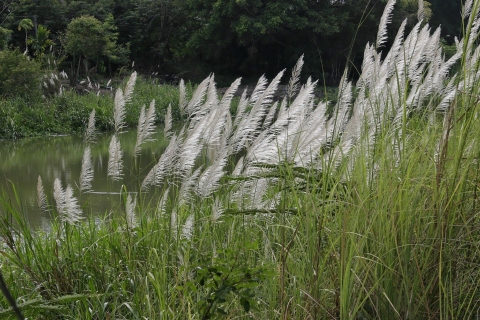Saccharum spontaneum
L.
Poaceae
Imperata klaga Jungh.
Imperata spontanea (L.) P.Beauv.
Saccharum angustifolium Reinw. ex Buse
Saccharum arenicola Ohwi
Saccharum caducum Tausch
Saccharum canaliculatum Roxb.
Saccharum chinense Nees ex Hook. & Arn.
Saccharum glaza Reinw. ex Blume
Saccharum insulare Brongn.
Saccharum juncifolium (Hack.) Jan.Ammal
Saccharum klaga (Jungh.) Steud.
Saccharum propinquum Steud.
Saccharum semidecumbens Roxb.
Saccharum speciosissimum Tausch
Saccharum stenophyllum Buse
Tricholaena semidecumbens (Roxb.) Schult.
Common Name: Wild Sugarcane

Fruiting plant in native habitat
Photograph by: Tony Rodd

General Information
Wild sugarcane is a perennial grass, free-tillering, often with aggressive rhizomes, capable of reaching a height of up to 8 metres, but normally within the range 2 - 3.5 metres[
].
It has been used in the breeding of sugarcane (S. Officinarum), as it provides vigour, hardiness and resistance to many major diseases[
].
Known Hazards
None known
Botanical References
200- Title
- The New RHS Dictionary of Gardening. 1992.
- Publication
-
- Author
- Huxley. A.
- Publisher
- MacMillan Press
- Year
- 1992
- ISBN
- 0-333-47494-5
- Description
- Excellent and very comprehensive, though it contains a number of silly mistakes. Readable yet also very detailed.
Range
Tropical and subtropical areas of Africa, E. Asia - India, Malaysia, Indo-China.
Habitat
Swamps, saline swamps, deserts, jungles, sandy river flats, and the low slopes of the Himalayas[
].
Properties
| Edibility Rating |      |
| Other Uses Rating |      |
| Habit | Perennial |
| Height | 3.00 m |
| Cultivation Status | Cultivated, Wild |
Cultivation Details
A plant of subtropical to tropical areas, where it is found from sea level to 1,700 metres[
]. Grows best in areas where the mean annual rainfall is within the range 25 - 35°c, though it can tolerate 17 - 40°c[
]. It prefers a mean annual rainfall in the range 2,000 - 3,000mm, tolerating 1,500 - 5,000mm[
].
Prefers a sunny position, succeeding in most soils[
]. Plants can succeed in wetter soils and are tolerant of seasonal inundation of the soil[
]. Tolerates moderate levels of salt in the soil[
]. Prefers a pH in the range 5 - 6, but can tolerate 4.5 - 7.5[
].
Edible Uses
The canes are a source of sugar, though the sucrose content is low and the fibre content high[
].
The hearts of the young shoots can be eaten raw or cooked as a side dish with rice[
46- Title
- Dictionary of Economic Plants.
- Publication
-
- Author
- Uphof. J. C. Th.
- Publisher
- Weinheim
- Year
- 1959
- ISBN
- -
- Description
- An excellent and very comprehensive guide but it only gives very short descriptions of the uses without any details of how to utilize the plants. Not for the casual reader.
,
301- Title
- Cornucopia II
- Publication
-
- Author
- Facciola. S.
- Publisher
- Kampong Publications, California.
- Year
- 1998
- ISBN
- 0-9628087-2-5
- Description
- The second edition of an excellent guide to the edible uses of plants, though it does not give any details of cultivation etc.
].
Very young inflorescences, whilst still enclosed by the leaf sheaths, eaten raw, steamed or roasted[
301- Title
- Cornucopia II
- Publication
-
- Author
- Facciola. S.
- Publisher
- Kampong Publications, California.
- Year
- 1998
- ISBN
- 0-9628087-2-5
- Description
- The second edition of an excellent guide to the edible uses of plants, though it does not give any details of cultivation etc.
]. A sweet flavour[
301- Title
- Cornucopia II
- Publication
-
- Author
- Facciola. S.
- Publisher
- Kampong Publications, California.
- Year
- 1998
- ISBN
- 0-9628087-2-5
- Description
- The second edition of an excellent guide to the edible uses of plants, though it does not give any details of cultivation etc.
].
The peeled rhizomes have a sweet flavour and are chewed by children as a substitute for sugar cane[
301- Title
- Cornucopia II
- Publication
-
- Author
- Facciola. S.
- Publisher
- Kampong Publications, California.
- Year
- 1998
- ISBN
- 0-9628087-2-5
- Description
- The second edition of an excellent guide to the edible uses of plants, though it does not give any details of cultivation etc.
].
The ash from burnt plants is used as a salt substitute[
301- Title
- Cornucopia II
- Publication
-
- Author
- Facciola. S.
- Publisher
- Kampong Publications, California.
- Year
- 1998
- ISBN
- 0-9628087-2-5
- Description
- The second edition of an excellent guide to the edible uses of plants, though it does not give any details of cultivation etc.
].
Medicinal
None known
Agroforestry Uses:
Plants are used for hedging or screening[
200- Title
- The New RHS Dictionary of Gardening. 1992.
- Publication
-
- Author
- Huxley. A.
- Publisher
- MacMillan Press
- Year
- 1992
- ISBN
- 0-333-47494-5
- Description
- Excellent and very comprehensive, though it contains a number of silly mistakes. Readable yet also very detailed.
].
Other Uses
The plant is a source of material for thatching[
272- Title
- Plants and People of Nepal
- Publication
-
- Author
- Manandhar. N. P.
- Publisher
- Timber Press. Oregon.
- Year
- 2002
- ISBN
- 0-88192-527-6
- Description
- Excellent book, covering over 1,500 species of useful plants from Nepal together with information on the geography and peoples of Nepal. Good descriptions of the plants with terse notes on their uses.
].
Propagation
Seed -
If you have any useful information about this plant, please leave a comment. Comments have to be approved before they are shown here.
 Useful Tropical Plants Database 2014 by
Ken Fern,
web interface by
Ajna Fern
with help from
Richard Morris.
Useful Tropical Plants Database 2014 by
Ken Fern,
web interface by
Ajna Fern
with help from
Richard Morris.